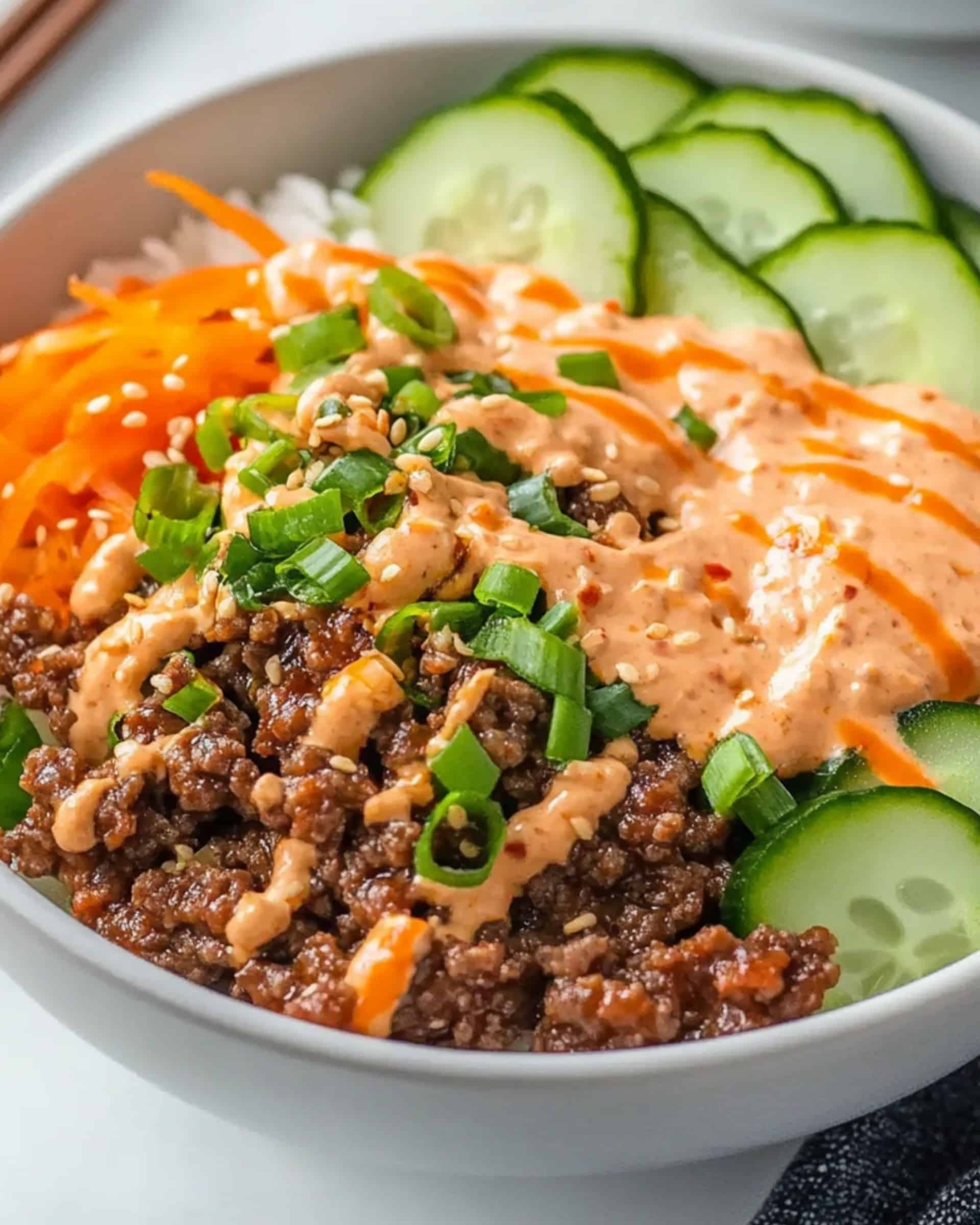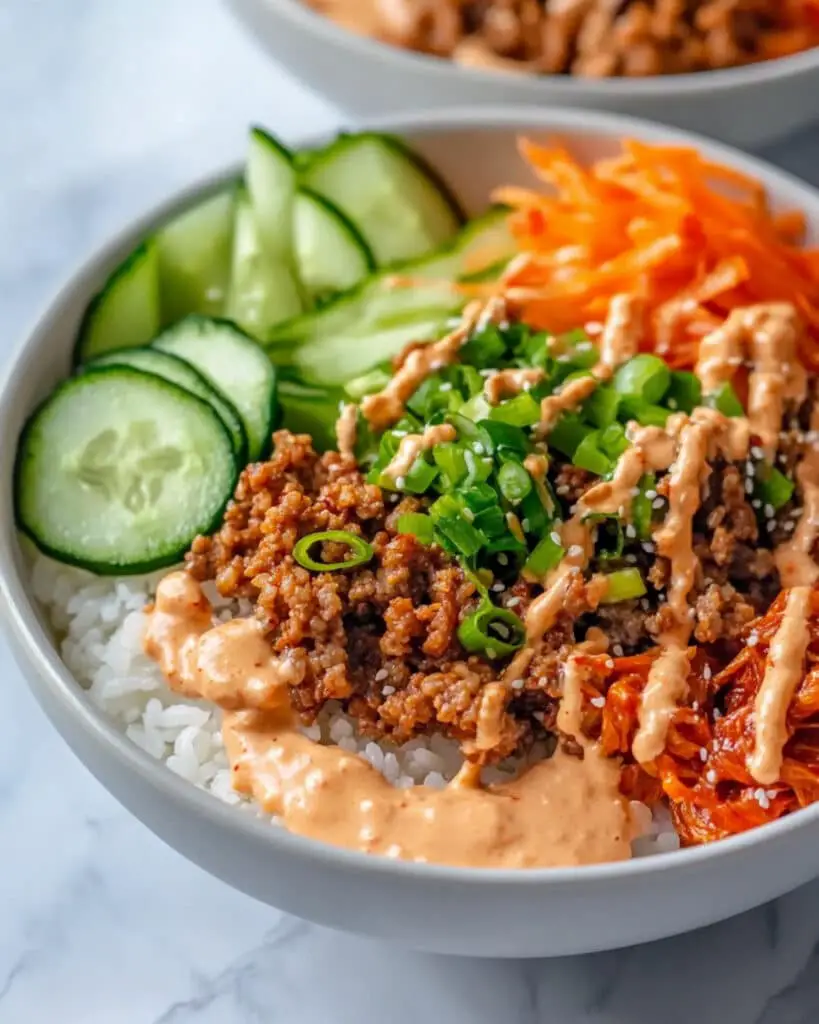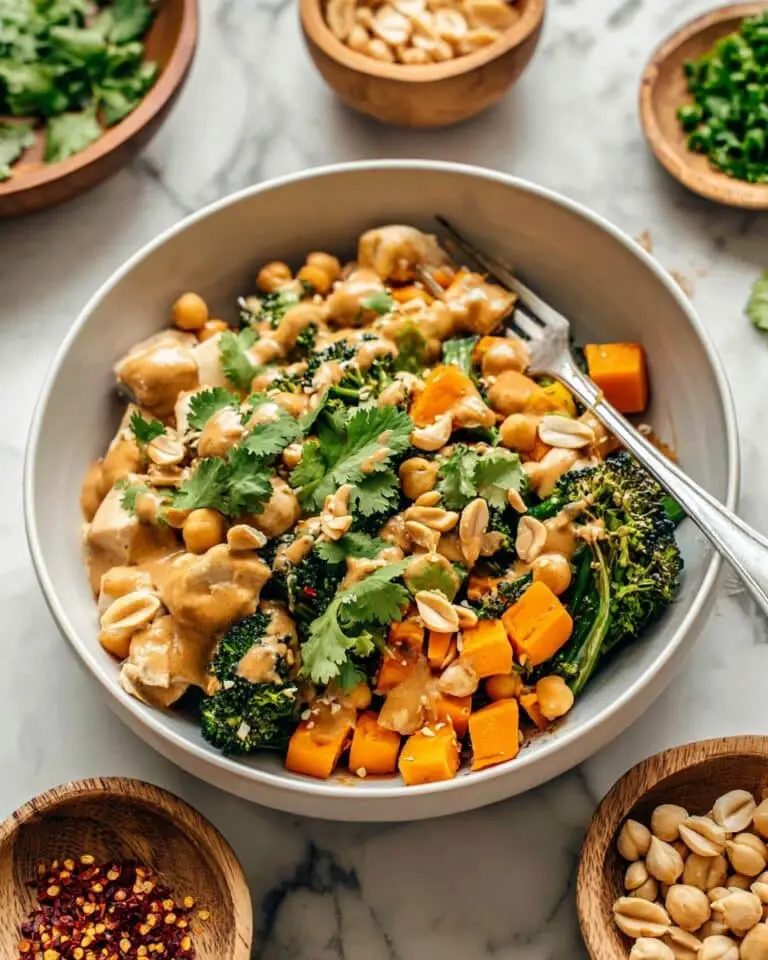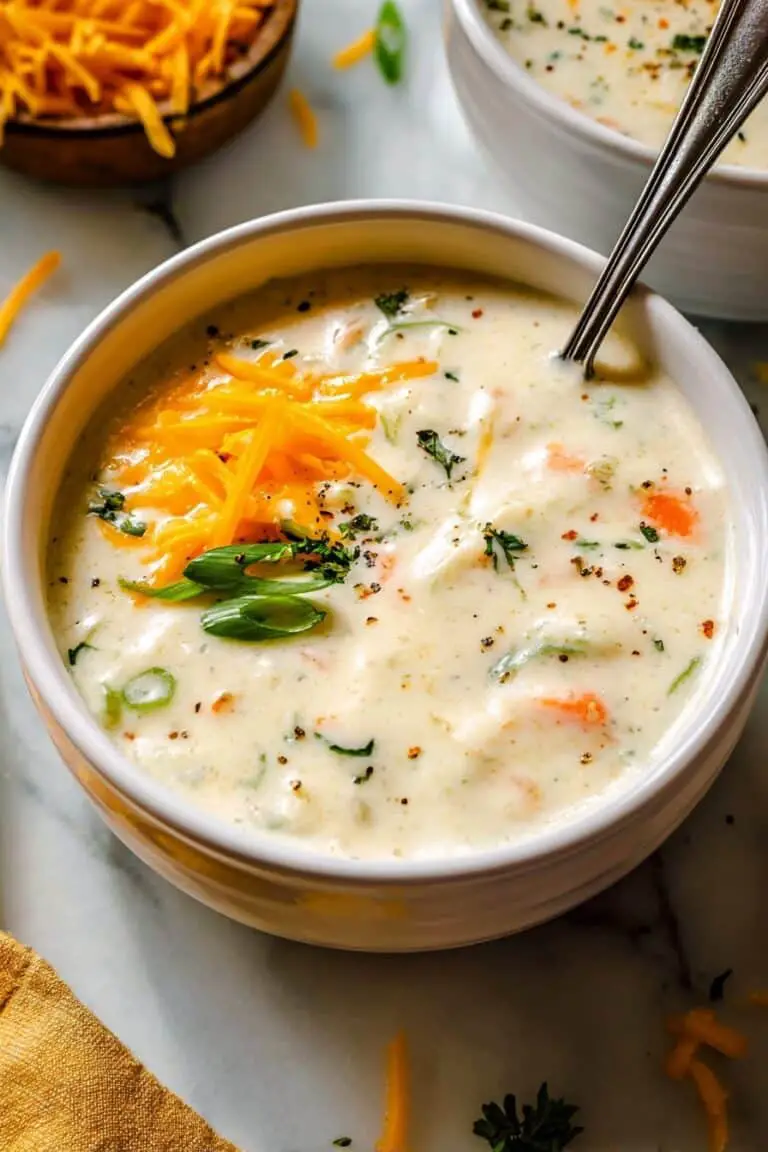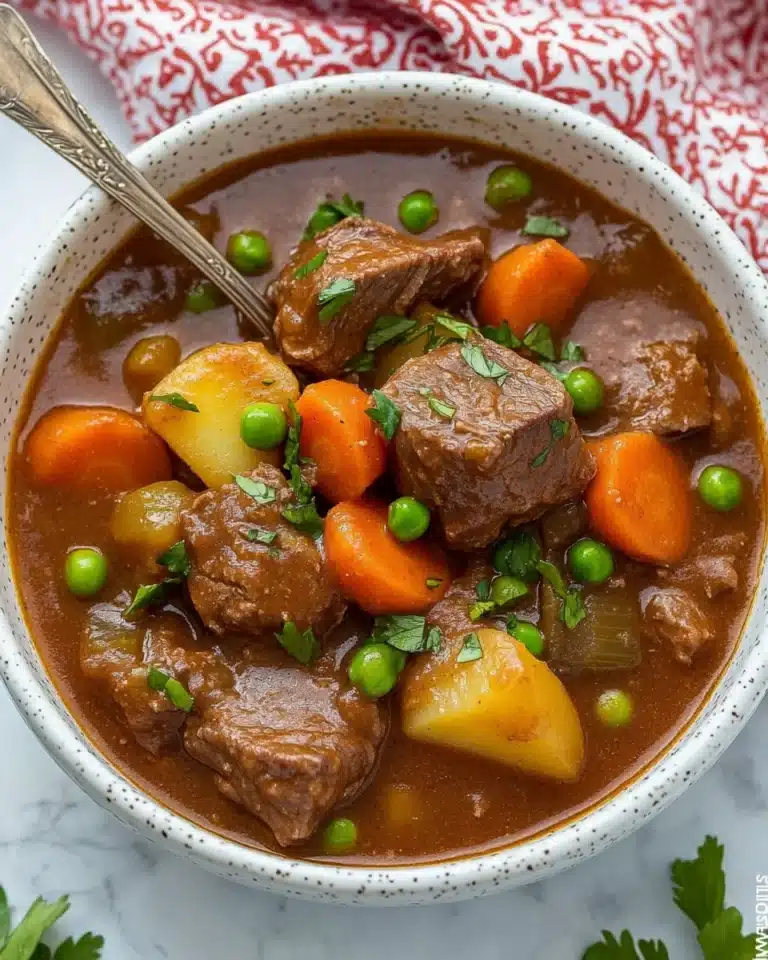This Korean Beef Rice Bowl is a flavor explosion that comes together in just 20 minutes flat. With tender ground beef simmered in a sweet-spicy sauce, fresh vegetables, and a creamy gochujang mayo drizzle, it’s the perfect balance of flavors and textures. Whether you’re new to Korean cuisine or a seasoned fan, this bowl will become your go-to weeknight dinner when you need something delicious without spending hours in the kitchen.
Why You’ll Love This Recipe
- Lightning Fast: From start to finish in 20 minutes – perfect for those nights when you’re starving and short on time.
- Flavor Powerhouse: The combination of ginger, garlic, soy sauce, and gochujang creates deep, complex flavors that taste like they took hours to develop.
- Customizable Heat: Easily adjust the spice level to suit everyone at your table, from spice-averse kids to heat-seeking adults.
- Complete Meal: Protein, carbs, and veggies all in one beautiful bowl – no need to worry about side dishes.
Ingredients You’ll Need
- Ground Beef: The star protein that soaks up all the wonderful flavors of the sauce. Choose lean or regular depending on your preference.
- Gochujang: This Korean chili paste is the secret weapon that brings authentic flavor and just the right amount of heat to your dish.
- Soy Sauce: Provides that essential umami depth that makes the beef irresistible.
- Brown Sugar: Balances the heat and saltiness with a touch of sweetness.
- Sesame Oil: Just a tablespoon transforms the entire dish with its distinctive nutty flavor.
- Garlic and Ginger: Fresh is definitely best here – these aromatics create the foundation of Korean cooking.
- Spring Onions: Add a bright, mild onion flavor and beautiful color contrast.
- Rice Vinegar: Brings a subtle acidity that balances the richness of the beef.
- Sesame Seeds: Provide a delightful texture and visual appeal.
- Jasmine Rice: Creates the perfect base to soak up all that delicious sauce.
- Fresh Vegetables: Crisp cucumber and carrot add refreshing crunch and make the bowl visually stunning.
- Kimchi: This fermented cabbage brings acidity and complexity that ties everything together.
- Mayonnaise: Creates a creamy drizzle that takes this bowl to restaurant-quality levels.
Note: You’ll find the complete list of ingredients, along with their exact measurements, in the printable recipe card at the bottom of this post.
Variations
Protein Options
Swap the ground beef for ground turkey or chicken for a lighter option. For a vegetarian version, use crumbled firm tofu or tempeh.
Veggie Variations
Add steamed broccoli, spinach, or thinly sliced bell peppers for extra nutrition and color.
Grain Alternatives
Replace jasmine rice with brown rice for additional fiber, or try cauliflower rice for a low-carb option.
Spice Adjustments
For fire-lovers, add a sprinkle of Korean red pepper flakes (gochugaru) or a drizzle of sriracha on top.
How to Make Korean Beef Rice Bowls
Step 1: Make the Stir-Fry Sauce
In a small bowl, combine the freshly grated garlic and ginger, soy sauce, brown sugar, sesame oil, gochujang, rice vinegar, and sesame seeds. Whisk until the sugar dissolves and everything is well incorporated. This sauce is the heart of your dish, so take a moment to taste and adjust to your preference.
Step 2: Cook the Beef
Heat your oil in a large frying pan over medium-high heat until it shimmers. Add the ground beef, breaking it up with a wooden spoon as it cooks. Brown it well – those caramelized bits add amazing flavor. Once browned, pour in your prepared stir-fry sauce and stir thoroughly to coat every bit of meat. Let it simmer for 2-3 minutes, watching as the sauce thickens and glazes the beef beautifully. Turn off the heat and stir in most of the sliced spring onions, saving some for garnish.
Step 3: Prepare the Mayo Drizzle
While the beef is cooking, quickly whisk together the mayonnaise, gochujang, sesame oil, and rice vinegar in a small bowl. This creamy, spicy sauce adds the perfect finishing touch to your bowls.
Step 4: Assemble Your Bowls
Start with a base of fluffy jasmine rice divided among four bowls. Top each with a generous portion of the saucy Korean beef mixture. Arrange the kimchi, julienned carrot, and cucumber slices around the beef. Drizzle the gochujang mayo over everything, then sprinkle with the reserved spring onions and extra sesame seeds for a beautiful presentation.
Pro Tips for Making the Recipe
- Don’t Overcook the Beef: Cook it just until no longer pink to keep it tender and juicy.
- Prep Ahead: Slice your vegetables and make both sauces earlier in the day to make dinner assembly lightning-fast.
- Sauce Consistency: If your beef sauce gets too thick, add a tablespoon of water to reach your desired consistency.
- Gochujang Introduction: If you’re new to gochujang, start with half the recommended amount and adjust to taste.
How to Serve
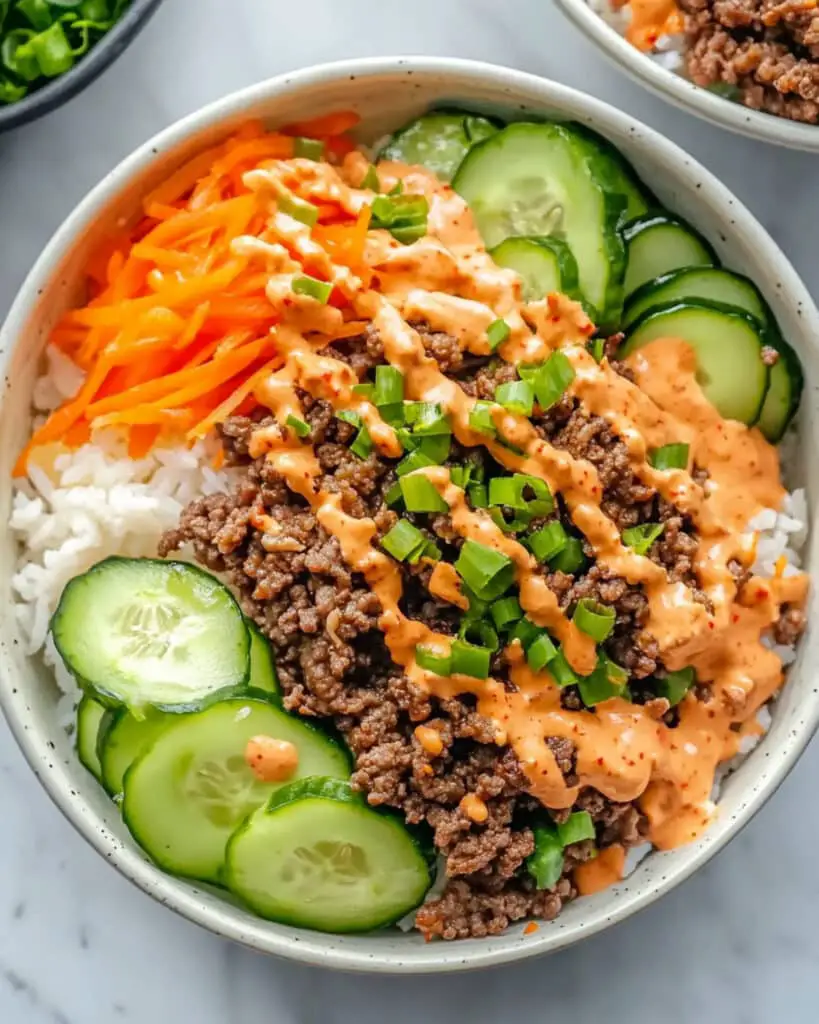
Perfect Pairings
These Korean beef bowls are delicious alongside a simple miso soup or a light cucumber salad dressed with rice vinegar and sesame oil.
Family Style
For a fun dinner, set up a DIY bowl bar with all the components separated so everyone can build their own perfect combination.
Drink Suggestions
Pair with cold beer, especially a light lager, or try a crisp, slightly sweet white wine like Riesling that complements the sweet-spicy flavors.
Make Ahead and Storage
Storing Leftovers
Store the cooked beef mixture separately from the rice and fresh vegetables in airtight containers in the refrigerator for up to 3 days. The mayo drizzle can be kept in its own container for the same period.
Freezing
The beef mixture freezes beautifully for up to 2 months. Thaw overnight in the refrigerator before reheating.
Reheating
Warm the beef in a skillet with a splash of water to revive the sauce. Microwave the rice with a sprinkle of water to prevent drying. Assemble with fresh vegetables and sauce.
FAQs
-
Can I make this recipe less spicy for kids?
Yes! Simply substitute the gochujang with tomato paste in the beef mixture and omit it completely from the mayo drizzle. You’ll still get wonderful flavor without the heat.
-
What exactly is gochujang and where can I find it?
Gochujang is a Korean fermented chili paste that adds a complex sweet-spicy flavor. You can find it in the international aisle of most large supermarkets, Asian grocery stores, or online. It keeps for months in the refrigerator after opening.
-
Can I prepare components of this meal in advance?
Absolutely! Make the beef mixture and mayo drizzle up to 3 days ahead. Cook fresh rice the day of serving, or reheat frozen rice. Slice vegetables just before serving for maximum freshness.
-
Is there a way to make this recipe vegetarian?
Definitely! Substitute the ground beef with crumbled firm tofu or tempeh. Just cook the plant-based protein with a bit more oil since it won’t release fat like beef does, and you may want to add a splash more soy sauce for flavor.
Final Thoughts
This Korean Beef Rice Bowl brings restaurant-quality Korean flavors to your kitchen with minimal effort. It’s the perfect introduction to Korean cooking for beginners, yet satisfying enough for those who love authentic flavors. The combination of sweet, spicy, savory, and fresh elements creates a perfectly balanced meal that will have everyone asking for seconds. Give it a try tonight – I promise your dinner routine will never be the same!
Print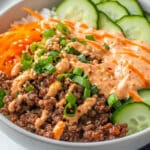
Korean Beef Rice Bowls Recipe
- Prep Time: 10 minutes
- Cook Time: 10 minutes
- Total Time: 20 minutes
- Yield: 4 servings 1x
- Category: Main-course
- Method: Stovetop
- Cuisine: Korean
Description
Korean Beef Rice Bowls are a delicious and easy-to-make dish, perfect for weeknight dinners. This flavorful recipe combines sautéed minced beef coated in a savory-sweet stir-fry sauce, served over fluffy jasmine rice, paired with vibrant kimchi, fresh veggies, and a creamy gochujang mayo drizzle. This recipe offers a perfect balance of umami flavors and contrasting textures that will excite your taste buds while keeping preparation quick and simple.
Ingredients
Stir-Fry Sauce
- 1 tsp freshly grated garlic
- 1 tsp freshly grated ginger
- 3 tbsp all-purpose soy sauce
- 2 tbsp brown sugar
- 1 tbsp sesame oil
- 1 tbsp gochujang (adjust for spice preference, see note 1 for substitutions)
- 1 tsp rice vinegar
- 1 tbsp sesame seeds, plus extra to garnish
Stir-Fry
- 2 tbsp extra-virgin olive oil or neutral oil
- 500 g (1 lb 2 oz) minced (ground) beef
- 2 spring onions (scallions), finely sliced (1 tbsp reserved for garnish)
Mayo Drizzle
- 3 tbsp whole-egg mayonnaise
- 1 tsp gochujang
- 1/2 tsp sesame oil
- 1/2 tsp rice vinegar
To Serve
- 2 cups (370 g) cooked jasmine rice
- 1 cup (240 g) kimchi
- 1 carrot, julienned
- 1 Lebanese (short) cucumber, sliced into half moons
Instructions
- Make the Stir-Fry Sauce
In a small bowl, whisk together the garlic, ginger, soy sauce, brown sugar, sesame oil, gochujang, rice vinegar, and sesame seeds until fully combined. Set aside. - Cook the Beef
Heat the oil in a large frying pan over medium–high heat. Add the minced beef and cook until it is browned, breaking it apart with a wooden spoon as it cooks. Pour in the prepared stir-fry sauce and stir to coat the beef evenly. Allow the mixture to simmer for 2–3 minutes until the sauce thickens slightly. Turn off the heat and stir in the spring onions, reserving some for garnish. - Prepare the Mayo Drizzle
In a small bowl, whisk together the mayonnaise, gochujang, sesame oil, and rice vinegar until smooth and creamy. Set aside. - Assemble the Bowl
Divide the cooked jasmine rice into four bowls. Top each bowl with the cooked beef, a generous portion of kimchi, julienned carrot, and sliced cucumber. Drizzle the gochujang mayo over the top and finish with a sprinkle of sesame seeds and reserved spring onion. Serve immediately and enjoy!
Notes
- If you are new to gochujang, start with 1 teaspoon and then adjust according to your spice preference. For a mild version, you can substitute tomato paste (concentrated puree) for gochujang in the stir-fry sauce and omit it in the mayo drizzle.
- To save time, pre-cook or use leftover jasmine rice.
Nutrition
- Serving Size: 1 Serving
- Calories: 500kcal
- Sugar: 10g
- Sodium: 800mg
- Fat: 28g
- Saturated Fat: 9g
- Unsaturated Fat: 17g
- Trans Fat: 0g
- Carbohydrates: 27g
- Fiber: 3g
- Protein: 30g
- Cholesterol: 80mg

